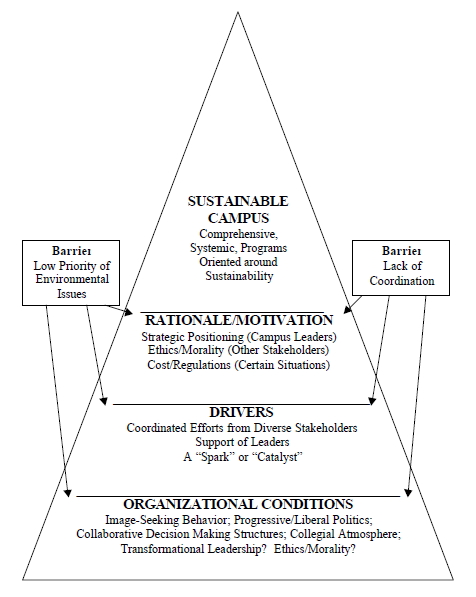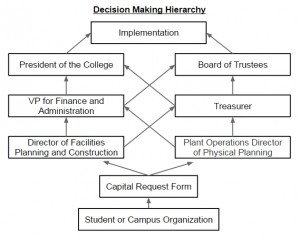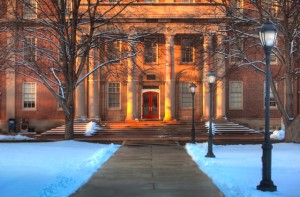Policy Analysis
In this section we will explore the political environment surrounding the implementation of a solar umbrella charging station here on campus and the growth of sustainable initiatives on college campuses around the nation. We will also outline the channels that have been navigated to bring this project to fruition. The first step in analyzing the project from a policy perspective was to determine the primary stakeholders of this endeavor; simply who this project is for and who can ultimately make the final decisions. The primary stakeholders of this project are the students and community members here at Lafayette, the Engineering Division and the Lafayette College Administration. The students and campus community members will ultimately be utilizing the new system on a daily basis to charge their electronic devices from a sustainable and renewable source. Although the students and campus community members will be utilizing the new technology, they have very little to no say in regards to the approval process. The Lafayette College administrative faculty must handle the approval process; the positions involved in a capital project request application include, but are not limited to, The Director of Facilities Planning and Construction, Plant Operations Director of Physical planning, Vice President of Finance and Administration as well as the Treasurer of the College. This brings us to our final stakeholders, the Engineering and Engineering Studies Program. The Engineering Division has been increasing its education and exposure in regards to sustainable practices and has acted as the branch under which we have worked to make the solar charging station a reality.
There has been a push for increased sustainable practices and initiatives at many of our nation’s colleges and universities. A push for a more penchant need for sustainable education that emphasizes a respect for the environment can be seen as early as 1990 in the form of the Talloires Declaration. This initiative was started when former president of Tufts University, Jean Mayer, organized 23 university leaders from around the world in Talloires, France to discuss the state of the world and create a document to outline actions universities must take to ensure a sustainable future. The Talloires Declaration has been signed by 265 university presidents and chancellors from over 40 countries (Clugston, 1999).
It is very easy for an institution to sign a document assuring a shift towards sustainable education and development but their are many organizational barriers that prevent an institution from making this shift. In an analysis conducted by Michael Shriberg on organizational factors influencing campus environmental performance and leadership he concluded that:
“Image-seeking behavior, collaborative decision making structures, collegial atmosphere and progressive/liberal political orientation are strong positive (non-environmental) conditions for success in campus sustainability efforts. However, these conditions are beneficial to campus sustainability only when strongly linked to environmental and social issues by change agents” (Shriberg, 2002).

Another aspect determining the success of campus sustainability initiatives involves exactly who is facilitating and driving change within a campus community. In order to bring about positive change it is imperative to have a diverse group of stakeholders, with the support of top leaders, to coordinate with each other and take advantage of an initial push for sustainability (Shriberg, 2002). In the case of our project, we have the support of the Engineering Studies Program and Sustainability Committee as well as many student organizations on campus that are looking to expand sustainability on our campus. The only factor holding this sustainability initiative back is the support of decision makers who have to ability to implement projects and initiatives brought forth. Figure 1 on the right is a visual that outlines organizational factors that may lead to a sustainable campus as well as barriers represented between each factor.
An organization that is proliferating the ideas of sustainability on college campuses is the Association for the Advancement of Sustainability in Higher Education (AASHE). The mission of the AASHE, “is to inspire and catalyze higher education to lead the global sustainability transformation”. They have established a website that outlines multiple initiatives at higher education institutions around the globe and give countless resources to improve the growing need for sustainable practices. This just demonstrates how more and more groups are getting involved in the sustainability movement and there are countless resources and outlets for more information and guidance for college campuses.
Moving on we will now define exactly who on our campus is able to implement the technology we wish to bring to campus. As stated above, many administrators are involved in the process required to implement a capital project on campus. The most invested is The Director of Facilities Planning and Construction; here at Lafayette the administration has a vision as to what the campus will look like many years into the future in terms of the physical layout as well as the aesthetics of the campus. These two aspects combine into a comprehensive plan of the direction of the campus in the near and distant future. In order to be able to implement the solar charging station we must convince the proper parties that this projects fits within the vision of Lafayette College progressing into an era focused on sustainable development and practices. This approval process is laid out very clearly on the Facilities Planning and Construction page on Lafayette College’s website. We will briefly explain the process we have gone through that is necessary in order to implement a new capital project on campus.

In order to implement a project such as this there are many different procedures we have followed. Here at Lafayette College we have a very clear and concise process in order to get approval to pursue a capital project here on campus. The first step of the process requires a Dean, Chair, Faculty Member or other College stakeholder to fill out the first section of a request form. They first section required a brief project description, cost estimate, department and division approvals and proposed funding sources. In the case of our project, we would develop the proposal under the guidance of Professor Benjamin Cohen, adviser to Engineering Studies Capstone projects. We have also gained support from the Engineering Division and Sustainability Committee. We have also been in contact with the manufacturer of the charging station and received a complete quote that we included with the request form. In order to further advance our initiative we created a petition for students to sign that are in support of the solar charging station. All but the aforementioned first step of the application process is tasked to administrative actors and those who have great influence on the direction and needs of the campus as a whole.

In the second step of the process, Director of Facilities Planning and Construction and Plant Operations Director of Physical Planning will first go over the proposal to review and then later confirm the scope of the project if deemed feasible. They must also take into consideration the estimated cost of the project and determine whether or not it is in compliance with the college’s strategic plan and campus master plan. In the case of our project we have a quote specific to our needs from the company that we have contracted to supply the power station so there is no need for modification. These discretionary decisions are made by administrators high up in Lafayette College’s decision making hierarchy. They often take into account the opinions of their colleagues as well as faculty members with greater professional understanding of nature of the proposal at hand. After going through the previous review process, if it is approved, the proposal then moves on to the various division heads such as the VP of Finance and Administration as well as the Treasurer of the College to determine a funding source, as well as total annualized and incremental costs. The only costs associated are the initial purchasing cost, the only maintenance required is that the panels are wiped off once every six weeks, this is a negligible operation and maintenance cost.
If the proposal makes it past these thorough review processes it is then approved to be pursued. If a project requires a large amount of funds or will significantly impact the direction of the College the President or Board of Trustees must approve it. In the case of our request, it would not require that level of administrative involvement. After the approval process, the project must then undergo the implementation process.
If the project fails the capital request procedure we must have an alternative that would still allow us to still implement our project. To combat a failed request we believe the Engineering Division would be able to take the lead since we have already laid out all of the initial ground work. This would provide a great opportunity for an interdisciplinary senior design project with a student from each engineering discipline to come together to reverse engineer and construct a solar charging station without the monetary limitations of buying a Solar Dok system from EnerFusion Incorporated. This would also allow students from outside of the Engineering discipline to be involved and look at community implications as well as economic restraints.

We can see a growing number of higher education institutions making progressive efforts to make their campuses more environmentally friendly to foster the idea of sustainable development. Lafayette College is a highly regarded engineering school and is often portrayed as a progressive institution but not nearly enough is being done to push the agenda on renewable energy technologies as well as sustainable development of the physical campus as well as the campus community. There are many stakeholders that would be involved in the decision making process as well as the implementation of our proposed technology. We see great potential in moving this project along from not just a strictly engineering perspective but also incorporating other departments and organizations around campus as an example of interdisciplinary cooperation at work.
Follow this link to explore the Technical Analysis of solar power and the EnerFusion Solar Power-Dok: Technical Analysis

Leave a Reply